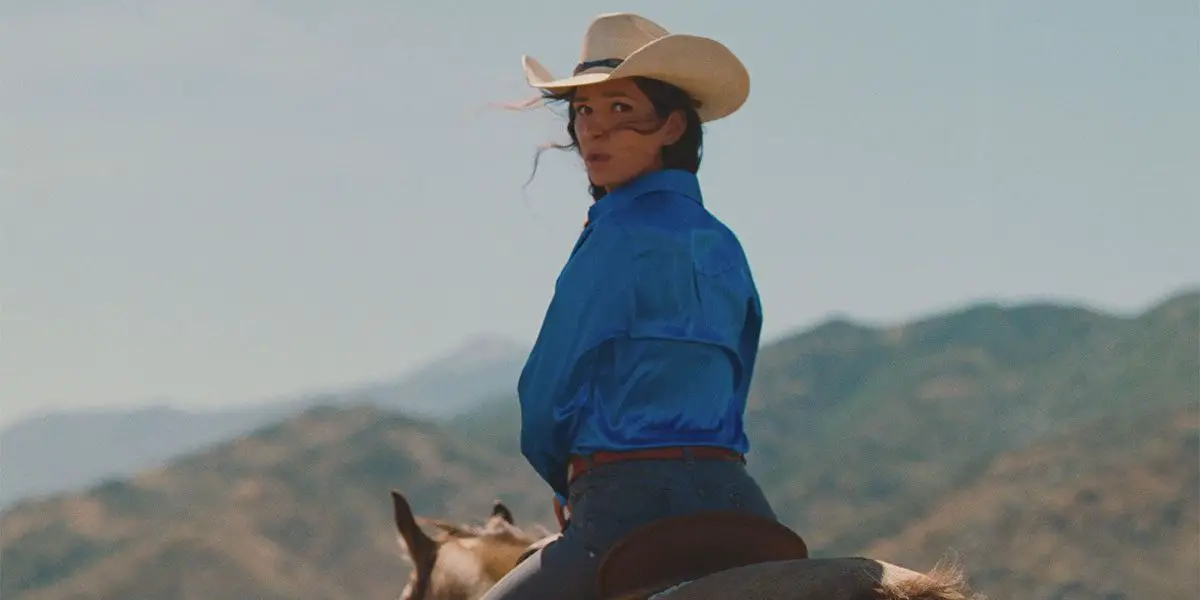The imagery and mythos of the American West have been cornerstones of U.S. cinema for decades. John Wayne and the large, empty expanse of the Southwestern United States are what come to mind when many think of this country. A sense of adventure, solitude, and masculinity has permeated every facet of the American culture. This feeds into the notion of the American Dream, the grittiness of pulling yourself by your bootstraps, and the idea that the only person you can rely on is yourself. It is the spirit of Americana that endures, but also isolates people who belong to minorities. Western films are not particularly kind to Indigenous people, individuals of color, women, etc. It’s not easy for people in those groups to feel as though the spirit of Americana belongs to them or that there’s a place for them here. Photographer Luke Gilford’s directorial debut, National Anthem, is a Western for the new world.
Dylan (Charlie Plummer) works in construction to help support his mother (Robyn Lively) and his little brother, Cassidy. His mom cuts hair, but the income isn’t consistent and she’d much rather drink with her friends than be a mother to her kids. Dylan picks up the slack because he adores his younger brother and tries to make his childhood the best it can be. Dylan is offered work on a ranch by Pepe (Rene Rosado), and upon arrival, he realizes the ranch is operated by and for queer people. He soon fully immerses himself into the community and finds himself falling in love with a barrel-racing rider, Sky (Eve Lindley). Along the way, Dylan opens up and explores feelings he’s long buried.

This gentle cowboy character is not new for Plummer. In 2017, he starred in Andrew Haigh’s Lean on Pete, about a teenage boy who takes an aging racehorse on a journey through the American West. In some ways, Plummer’s National Anthem character feels like a continuation of his role in Lean on Pete. Both are sensitive, quiet young men who want to earn an honest living and do no harm to the people they encounter. In some ways, they’re the cowboys of yesteryear. Their favorite company is their own, they know how to live off the land, and they have a simple, distinct style. What’s so stunning about National Anthem is that the film is essentially Dylan’s pursuit to become himself and the bravery that requires. The script gives him the space and support to try performing as a drag queen and bull riding for the first time. Both take bravery, both take him outside his comfort zone, and he finds support from his community during both. The cowboy idea of masculinity exists in the same breath as the queerness of drag, and neither detracts from the other. That’s just Dylan.
One of the film’s final moments is a drag queen singing the U. S. national anthem before a rodeo. That song became a point of contention in the United States after NFL player Colin Kapernick knelt to protest police brutality against Black Americans. It has become clear that the anthem doesn’t make everyone feel a part of this country. In fact, it can be isolating because the America the anthem is describing often mistreats minority groups. Listening to a drag queen passionately sing the Star Spangled Banner, surrounded by all different kinds of people, as the Pride flag ripples in the wind, is unexpectedly emotional. This moment, and all of National Anthem, is a reclamation of the freedom of the American West by the people who were excluded from it.

Miraculously, Gilford shot National Anthem in seventeen days on film, and there’s not a moment that feels lost because of time or budget constraints. Watching a first-time director so confidently capture his subjects with limited resources makes the audience excited to see what comes next. Gilford was already comfortable working on film rather than digital, and the grainy warmth of the medium places National Anthem within the world of famous Westerns shot on film. Gilford has captured images that have existed for decades, but in the place of traditional, macho cowboys, he has queer, trans, and non-binary people riding through New Mexico on horseback. Gilford goes from purely landscape shots to extreme close-ups of his characters, intrinsically tying them to this place and all of its history.
National Anthem is a stunning debut from Gilford and a career high for Plummer. It also speaks to the atmosphere that Gilford created on set that allowed his non-actors to flourish as magnificently as his traditional actors. While the general plot of a young man finding himself has been seen before and will be seen again, the magic of National Anthem is in the way the narrative is presented. The film is a blueprint for a new way of life. One that’s kinder, more community-focused, and that embraces differences. National Anthem is patriotic, and hopeful for what America can become.




